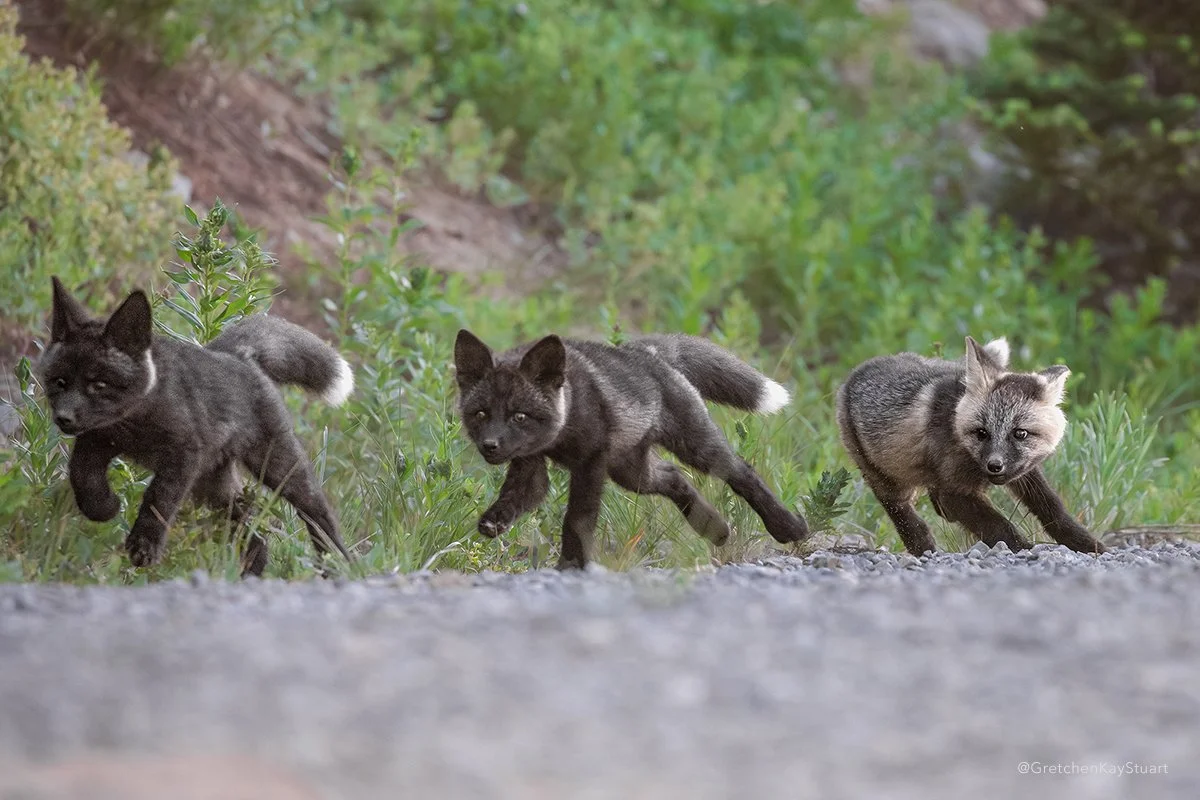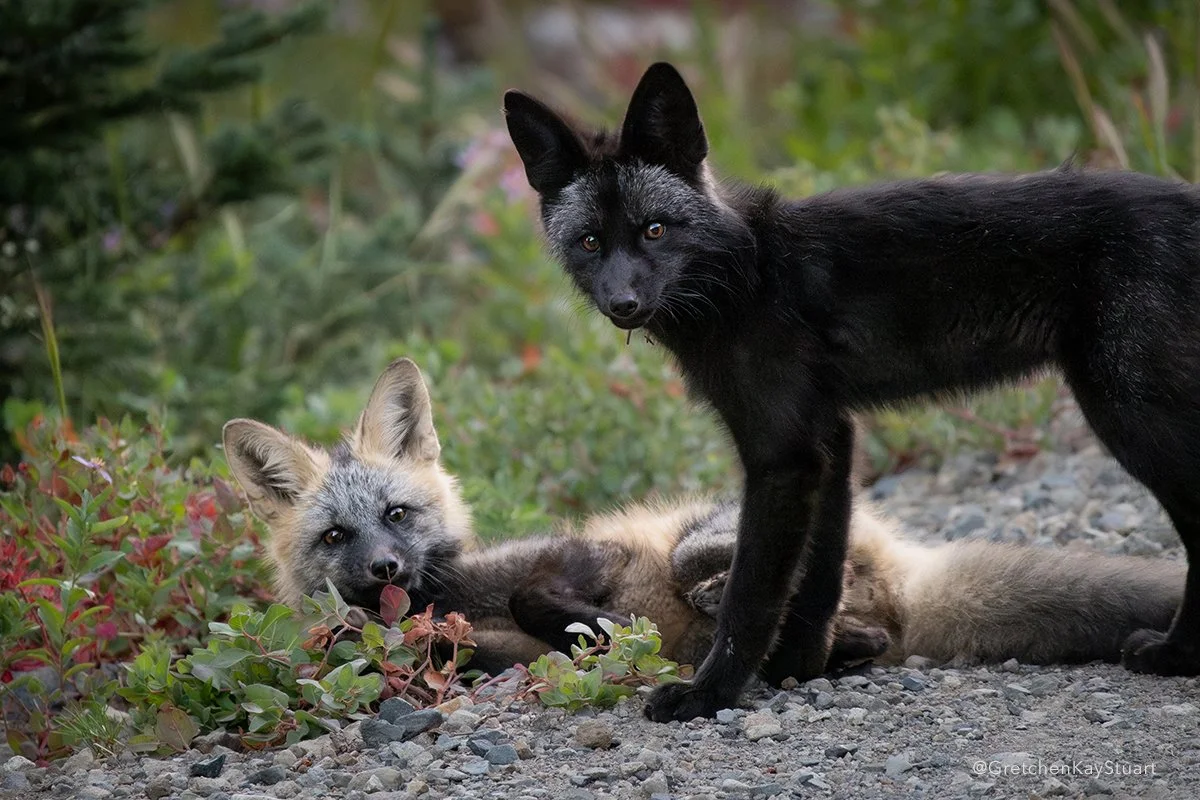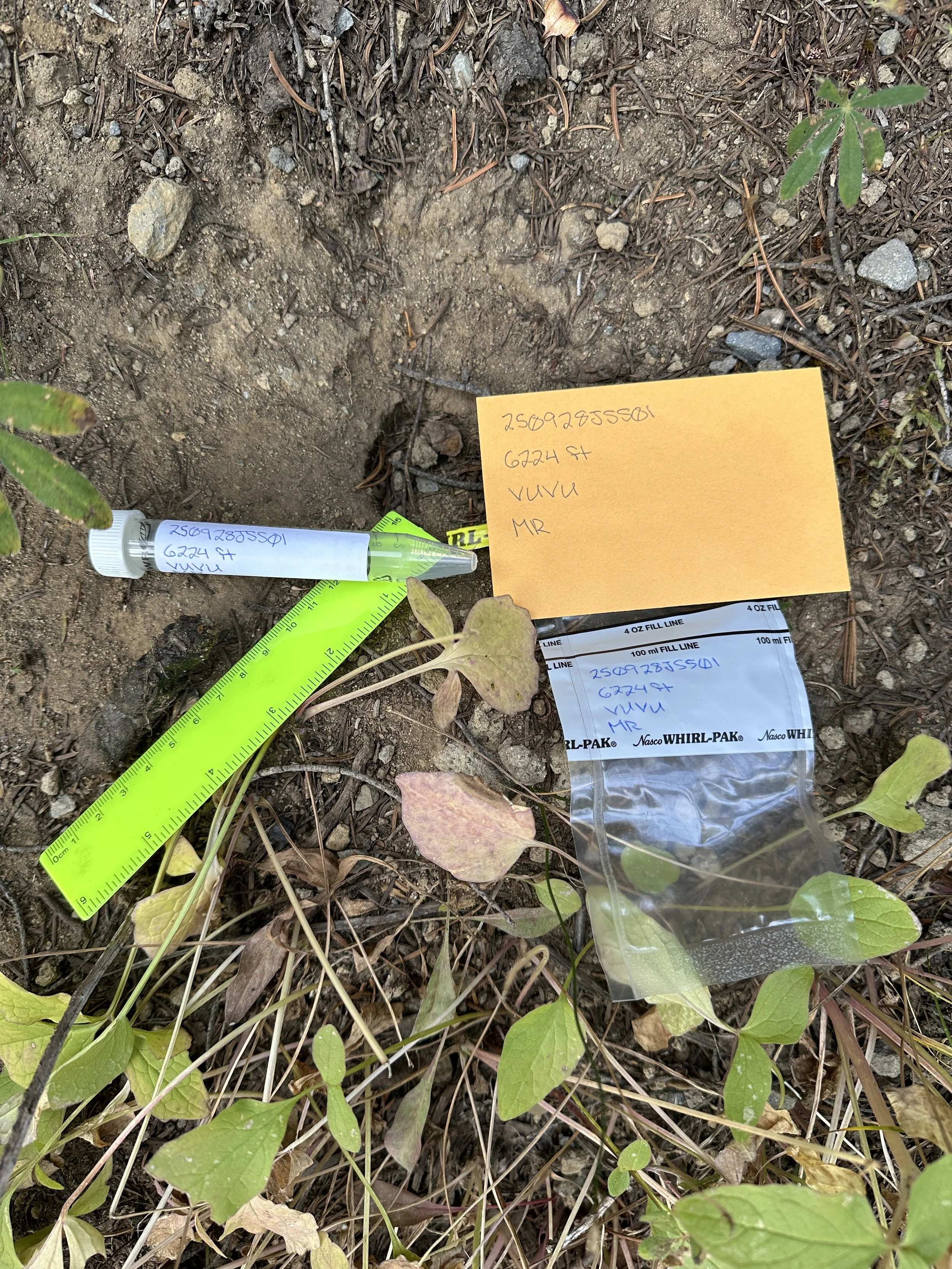HOW DOES DNA HELP WITH CARNIVORE CONSERVATION? (Part 1)
Read moreGRETCHEN'S DEN DISCOVERIES (Post #1)
Words and Photos By Gretchen Kay Stuart
Last June, a routine patrol by a Meadow Rover, (a volunteer who educates visitors about the fragile wildflower meadows at Mount Rainier National Park), resulted in the discovery of three Cascade red fox kits. At approximately two months old, these vulnerable pups belonged to the first active den found within park boundaries since 2017. To shield them from the dangers of human crowds and food-conditioning, the National Park Service took immediate action, establishing a protective closure around the den site.
In my sixth year of field efforts dedicated to studying this elusive subspecies, this was a dream scenario. As part of a science team, I had access to monitor the den site, allowing me to conduct daily in-depth observations of Cascade red fox kit rearing. While I am saving the most exciting findings for future posts, today, I would like to introduce you to the three adorable kits at the heart of this story.
The Cross-Phase Male: In my field notes, I initially called this distinctive kit “Cross.” But during a Q&A I held with park Rangers, the perfect name was suggested: Sunny. It suited him wonderfully, and the name stuck.
The Two Black-Phase Sisters: We believe two kits are females due to the ability to zoom in on high resolution photos.
One sister has slightly lighter markings on her belly. I gave her the temporary name "Loner" because I often found her at a separate den entrance from her siblings—perhaps a clever strategy to spread the risk if a predator were to discover them.
The other sister, whom I logged as "2B" (for 2nd black kit), was the bold explorer of the family. Her insatiable curiosity quickly won me over and I developed a special fondness for her emerging personality.
Official naming of the sisters is still to come. I hope the honor will go to the incredible team of Meadow Rovers who diligently stood guard at trailheads for this fox family over the most sensitive months of their development.
To ensure my presence did not disrupt their natural behavior, my observations were made from a blind at a distance using a long lens. This allowed me to witness the fox family’s authentic world without obvious disturbance.
This is just the beginning of the story. Stay tuned for more den discoveries in upcoming posts!
THE RIPPLE EFFECT OF VOLUNTEERING
How Scat Collection Inspired a Scientist and Gained a Board Member
Words and Photos by John Soltys
Mount Rainier National Park is where my kids and I first became community scientists more than 10 years ago and where I first collected scat for Cascades Carnivore Project. On one of the last nice days of the year, my daughter, now an environmental science graduate from the University of Washington, joined me to search for scat. We hiked a five mile loop and collected four samples from Cascade red foxes. Each collection takes just a few minutes and each time we stopped we got to talk with other hikers about the work CCP does. It's easy to share our passion for community science with others. Hopefully it will influence them the way it did my kids, turning them into scientists. It sure worked on me. I started as a volunteer in the field; now I'm a member of the Board of Directors for CCP. My contributions to the Board are administrative, in line with my professional life. But given half a chance, you'll find me, and probably my kids, looking for scat high in the mountains. Between Paradise and Sunrise, there are plenty of opportunities to contribute to CCP’s research year-round. I hope to see you out there!
POISON IN THE FOOD CHAIN: WHAT RODENTICIDES MEAN FOR THE CASCADE RED FOX
Words By Caitlin Beebe
One of the rarest carnivores in North America lives in Washington’s Cascade Mountain Range: the Cascade red fox. This unique, mountain fox is adapted to alpine and subalpine habitats of the Cascades, endures harsh winters, varying snowpacks, and rugged terrain; yet its presence is waning. One increasingly relevant threat is anticoagulant rodenticides.
What are Anticoagulant Rodenticides?
Rodenticides are a type of poison that are designed to kill rodents such as voles, mice and chipmunks–several of the main prey sources for foxes and other carnivores. These poisons work by traveling through the body to interfere with blood coagulation, clotting, and cause spontaneous bleeding. The poison remains volatile in rodents beyond death: a carnivore that consumes the rodent either as prey or from scavenging a carcass can also be poisoned. Sometimes the volume is small enough that it simply makes the animal sick, but often, the secondary poisoning will cause mange or death.
Impacts to Cascade Red Foxes
Cascade red foxes have been observed displaying symptoms of poisoning and their carcasses have been found in recreational areas of Washington’s National Forests. Wherever there is an abundance of humans, we find an abundance of rodents, as rodents are drawn to the excess food and garbage that comes along with human habitation in these wild places. In order to control rodent populations, resorts and recreational sites will set out rodenticides underneath and around buildings and other structures that foxes may use for protection while raising young. When rodenticides are used in places with known foxes, the foxes could be impacted.
Cascade red foxes are a prey generalist that eats a diversity of food items, including small and mid-sized mammals, insects, fruit, birds and carrion. Despite their generalist nature, their diet is mostly made up of small rodents that act as the primary pathway for the fox to be poisoned by rodenticides. When rodenticides are present in a system, all carnivores are affected, but species like CRF that are already vulnerable due to their small population numbers are especially impacted by rodenticides. The loss of a single breeding adult or kit could have severe consequences for the species’ survival. As recreation and development expand into alpine regions, the risk of exposure grows. ARs used around infrastructures such as cabins or ski resorts do not stay contained – they ripple outward into the food web, and unlike species with larger, more stable populations, the CRF has no margin for error.
Safer Paths Forward
Across the West, communities are addressing the fatal use of rodenticides, and showing that there are alternative solutions to addressing rodent problems without poisoning wildlife.
Effective alternatives include:
Rodent-proofing buildings with exclusion barriers.
Reducing attractants by securing food, trash, and compost.
Mechanical traps in protective boxes to reduce and prevent bycatch of non-target species.
Rodent fertility control products like ContraPest, which in field studies reduced rodent activity by up to 94% when used alongside exclusion measures.
What You Can Do
Protecting Cascade red foxes and other wildlife starts with choices we can make in our own backyards:
Avoid rodenticides and encourage your neighbors, home owners association, and local businesses to support alternative solutions.
Support non-toxic pest management policies in your local city, county, and at state level by supporting legislation that restricts the use of the most dangerous rodenticides.
Volunteer or donate to wildlife monitoring and conservation projects, including efforts to protect Cascade red foxes.
Spread the word: many people simply do not know the impacts rodenticides have on wildlife
Contact Washington’s legislators to demand that rodenticides are immediately removed from Cascade red fox habitat and voice support for a state-wide ban.
By replacing these poisons with safer, effective alternatives, we can limit our impact and take tangible steps towards safeguarding its future, and support the CRF’s ability to persist in the Cascades for years to come.
Further Reading:
https://www.nps.gov/samo/learn/management/rodenticides.htm
https://cwhl.vet.cornell.edu/disease/rodenticide-toxicity
https://wdfw.wa.gov/publications/02310
https://digitalcommons.unl.edu/cgi/viewcontent.cgi?article=3528&context=icwdm_usdanwrc
https://wdfw.wa.gov/species-habitats/species/vulpes-vulpes-cascadensis#desc-range
A Crucial Reminder About Social Media & Imperiled Species
Social Media posts can have unintended consequences. Here’s how to be a responsible advocate for the species we protect.
Read moreScat Collecting Volunteers & Their Unforgettable Find
My husband and I had the unbelievable experience of camping by a remote Cascade red fox den and watching a mama fox and a kit playing, snuggling, and hanging out for a whole evening and morning!
Read more










